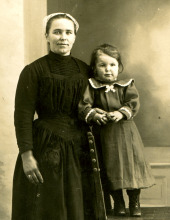
Marie-Josèphe Bertrand (1886-1970), born Martay, known as "Madame Bertrand" and nicknamed Joze Ar c'hoad in Breton - literally: "Josée du Bois", was a Breton singer who influenced many contemporary artists.
Born in Plounévez-Quintin, she grew up in a poor family of daily agricultural workers where singing played a central role. Daughter of singers, she acquired the style and repertoire of her parents made up of songs to listen to, dance, and walk. She performs publicly from the age of 12 during vigils, fairs, weddings, sometimes accompanied by her father or her sisters.
In 1902, aged 15, she married a clog maker from Saint-Nicolas-du-Pélem, Vincent Bertrand (alias Mathurin or Matao) and at the age of 17 gave birth to the first of their six children. They live in a hut (lochenn) with very rudimentary comfort in the middle of a beech grove, hence its nickname "Josée du bois", and change locations according to the sites. Marie-Josèphe then learns to know medicinal plants and exercises her healing talents.
In 1919, with her husband back from the war, they moved to Canihuel as clog makers. In 1924, Madame Bertrand opened a café. She sings according to her desires and sometimes to animate gatherings. When the first "modern" fest-noz were organized, her son Guillaume took her to participate in competitions where she won prizes.
Her repertoire was collected by Claudine Mazéas between 1959 and 1965, among which her interpretation of Skolvan's gwerz will remain famous.
She died in 1970 at the age of 84.
Many Breton musicians consider her to be an exceptional singer and her performances are a source of inspiration for many of them. Various records and publications, notably edited and published by Dastum, are devoted to him.
Photo: Madame Bertrand with her daughter Madeleine, in 1915 or 1916 © Michel and Nicole Sohier ; Madame Bertrand eand her grandson Guy, in 1935 at Canihuel © Paulette Simon-Bertrand
Née en Plounévez-Quintin, elle grandit dans une famille pauvre de journaliers agricoles où le chant tient une place centrale. Fille de chanteurs, elle acquiert le style et le répertoire de ses parents constitué de chants à écouter, à danser, et à la marche. Elle se produit publiquement à partir de l'âge de 12 ans lors des veillées, foires, mariages, parfois accompagnée de son père ou de ses sœurs.
En 1902, âgée de 15 ans, elle se marie à un sabotier de Saint-Nicolas-du-Pélem, Vincent Bertrand (alias Mathurin ou Matao) et donne naissance à l'âge de 17 ans au premier de leurs six enfants. Ils vivent dans une hutte (lochenn) au confort très rudimentaire au milieu d'une hêtraie, d'où son surnom de « Josée du bois », et changent d’emplacements au gré des chantiers. Marie-Josèphe apprend alors à connaître les plantes médicinales et exerce ses talents de guérisseuse.
En 1919, avec son mari revenu de la guerre, ils s’installent à Canihuel comme sabotiers. En 1924, Madame Bertrand ouvre un café. Elle chante selon ses envies et parfois pour animer des rassemblements. Lorsque s’organisent les premiers fest-noz « modernes », son fils Guillaume l'emmène participer à des concours où elle remporte des prix.
Son répertoire fait l'objet de collectages par Claudine Mazéas entre 1959 et 1965, parmi lesquels son interprétation de la gwerz de Skolvan restera célèbre.
Elle meurt en 1970 à 84 ans.
De nombreux musiciens bretons la considèrent comme une chanteuse d’exception et ses interprétations constituent une source d’inspiration pour nombre d’entre eux. Différents disques et publications, notamment édités et publiés par Dastum, lui sont consacrés.
Oeuvre interprétée par Madame Bertrand
Photos : Madame Bertrand avec sa fille Madeleine, en 1915 ou 1916 © Michel et Nicole Sohier ; Madame Bertrand et son petit-fils Guy, en 1935 à Canihuel © Paulette Simon-Bertrand.